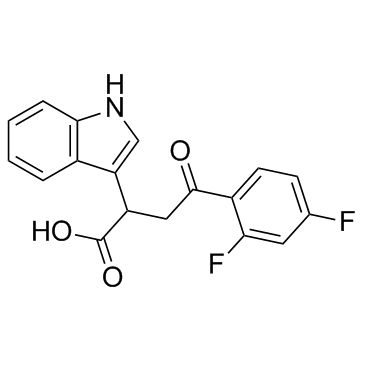Physicochemical Properties
| Molecular Formula | C18H13F2NO3 |
| Molecular Weight | 329.297531843185 |
| Exact Mass | 329.086 |
| Elemental Analysis | C, 65.65; H, 3.98; F, 11.54; N, 4.25; O, 14.58 |
| CAS # | 1354707-41-7 |
| PubChem CID | 76070959 |
| Appearance | Light yellow to yellow solid powder |
| LogP | 3.1 |
| Hydrogen Bond Donor Count | 2 |
| Hydrogen Bond Acceptor Count | 5 |
| Rotatable Bond Count | 5 |
| Heavy Atom Count | 24 |
| Complexity | 487 |
| Defined Atom Stereocenter Count | 0 |
| InChi Key | BOKQALWNGNLTOC-UHFFFAOYSA-N |
| InChi Code | InChI=1S/C18H13F2NO3/c19-10-5-6-12(15(20)7-10)17(22)8-13(18(23)24)14-9-21-16-4-2-1-3-11(14)16/h1-7,9,13,21H,8H2,(H,23,24) |
| Chemical Name | 4-(2,4-difluorophenyl)-2-(1H-indol-3-yl)-4-oxobutanoic acid |
| Synonyms | MA 5 MA-5 Mitochonic Acid 5 |
| HS Tariff Code | 2934.99.9001 |
| Storage |
Powder-20°C 3 years 4°C 2 years In solvent -80°C 6 months -20°C 1 month |
| Shipping Condition | Room temperature (This product is stable at ambient temperature for a few days during ordinary shipping and time spent in Customs) |
Biological Activity
| ln Vitro | ATP generation in mitochondria is regulated by mitochondrial acid 5 (MA-5), which is not influenced by the electron transport chain or oxidative phosphorylation. Increased mitochondrial oxidation and ATP depletion are caused by mitochondrial malfunction and are linked to regeneration in a range of mitochondrial disorders [1]. The plant growth hormone regulator-3-receptor, from which (MA-5) is derived, controls energy stimulation and lowers mitochondrial oxidation to safeguard mitochondrial function. The MTT assay was used to assess cell viability in order to see the protective impact of mitochondrial acid 5 on asteroid cells in controlled conditions. Treatment with TNFα resulted in a considerable reduction in cell viability. Treatment with mitochondrial acid 5 reduces this effect, but, in a dependent way [2]. |
| ln Vivo | In animal models of cardiac reperfusion injury and cisplatin-induced nephropathy, mitochondrial acid 5 (MA-5) enhances renal function. The study aimed to investigate the protective effects of mitochondrial acid 5 on tissue bioavailability. At a peak time of one hour, mitochondria acid 5 raises the Manhattan concentration in a dose-response manner [1]. |
| References |
[1]. Mitochonic Acid 5 Binds Mitochondria and Ameliorates Renal Tubular and Cardiac Myocyte Damage. J Am Soc Nephrol. 2016 Jul;27(7):1925-32. [2]. Mitochonic acid 5 activates the MAPK-ERK-yap signaling pathways to protect mouse microglial BV-2 cells against TNFα-induced apoptosis via increased Bnip3-related mitophagy. Cell Mol Biol Lett. 2018 Apr 5;23:14. |
Solubility Data
| Solubility (In Vitro) |
DMSO : ≥ 106.66 mg/mL (~323.90 mM) H2O : < 0.1 mg/mL |
| Solubility (In Vivo) |
Solubility in Formulation 1: ≥ 2.5 mg/mL (7.59 mM) (saturation unknown) in 10% DMSO + 40% PEG300 + 5% Tween80 + 45% Saline (add these co-solvents sequentially from left to right, and one by one), clear solution. For example, if 1 mL of working solution is to be prepared, you can add 100 μL of 25.0 mg/mL clear DMSO stock solution to 400 μL PEG300 and mix evenly; then add 50 μL Tween-80 to the above solution and mix evenly; then add 450 μL normal saline to adjust the volume to 1 mL. Preparation of saline: Dissolve 0.9 g of sodium chloride in 100 mL ddH₂ O to obtain a clear solution. Solubility in Formulation 2: ≥ 2.5 mg/mL (7.59 mM) (saturation unknown) in 10% DMSO + 90% (20% SBE-β-CD in Saline) (add these co-solvents sequentially from left to right, and one by one), clear solution. For example, if 1 mL of working solution is to be prepared, you can add 100 μL of 25.0 mg/mL clear DMSO stock solution to 900 μL of 20% SBE-β-CD physiological saline solution and mix evenly. Preparation of 20% SBE-β-CD in Saline (4°C,1 week): Dissolve 2 g SBE-β-CD in 10 mL saline to obtain a clear solution. Solubility in Formulation 3: ≥ 2.5 mg/mL (7.59 mM) (saturation unknown) in 10% DMSO + 90% Corn Oil (add these co-solvents sequentially from left to right, and one by one), clear solution. For example, if 1 mL of working solution is to be prepared, you can add 100 μL of 25.0 mg/mL clear DMSO stock solution to 900 μL of corn oil and mix evenly. (Please use freshly prepared in vivo formulations for optimal results.) |
| Preparing Stock Solutions | 1 mg | 5 mg | 10 mg | |
| 1 mM | 3.0367 mL | 15.1837 mL | 30.3674 mL | |
| 5 mM | 0.6073 mL | 3.0367 mL | 6.0735 mL | |
| 10 mM | 0.3037 mL | 1.5184 mL | 3.0367 mL |
